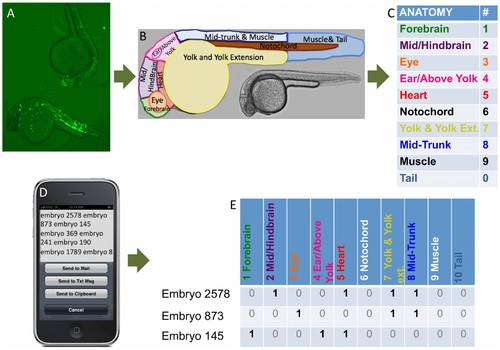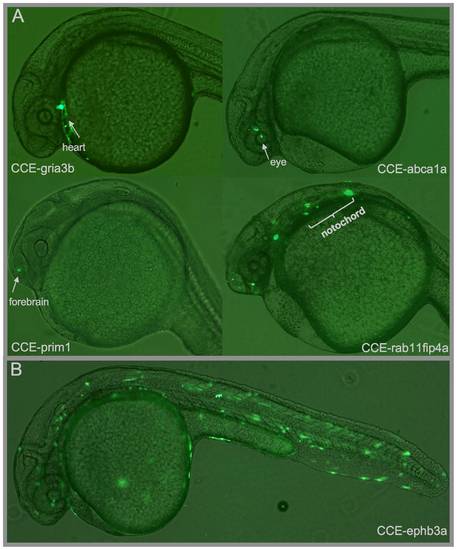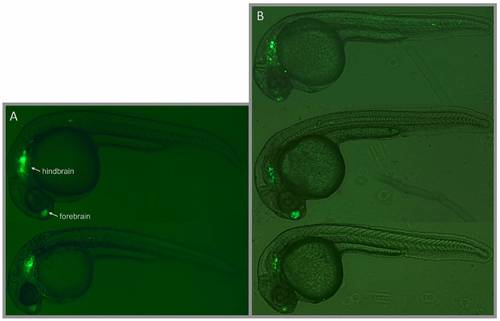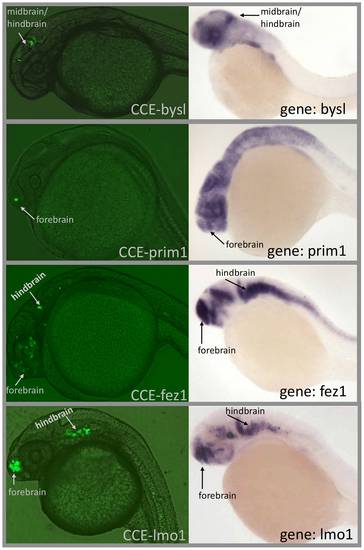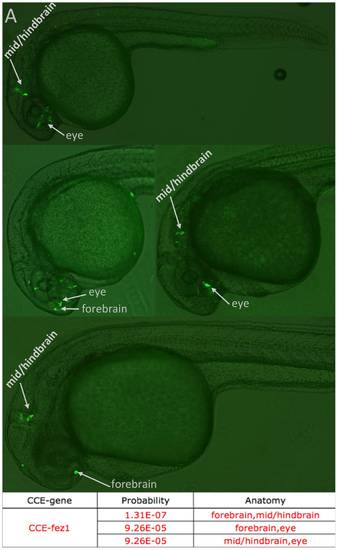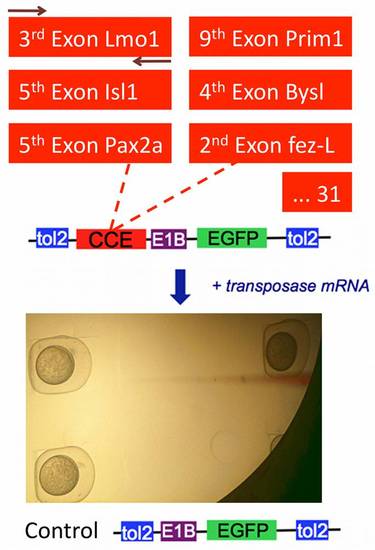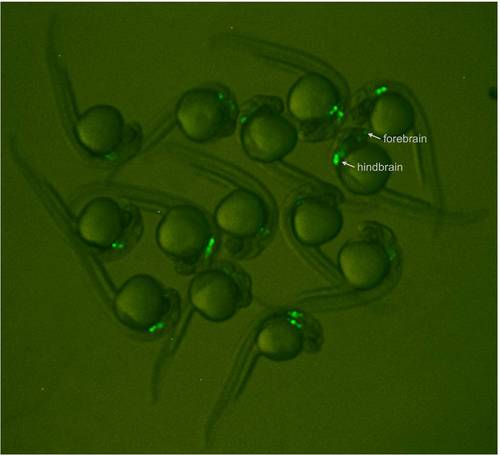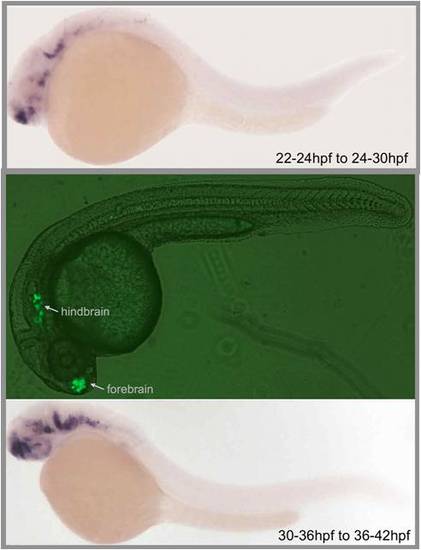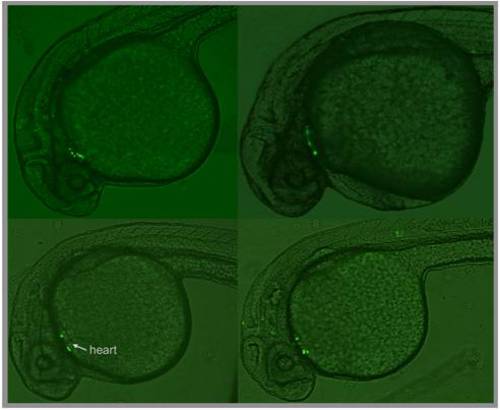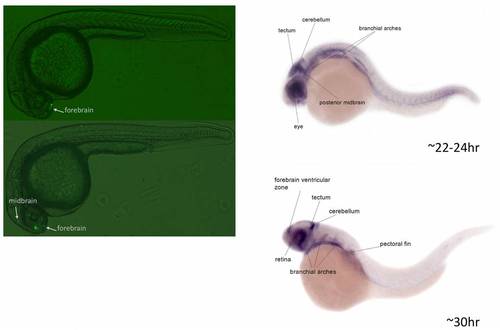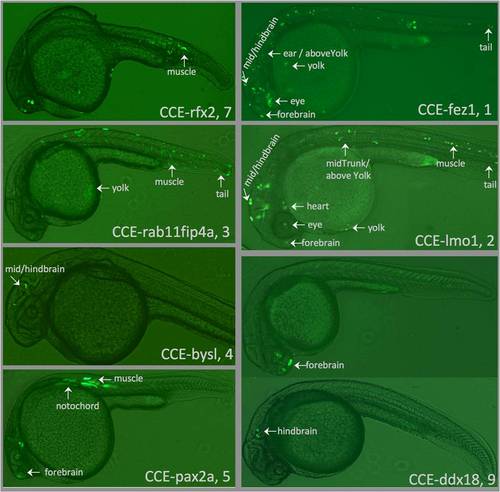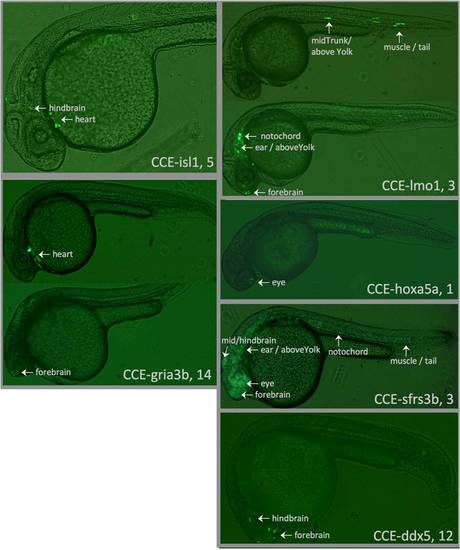- Title
-
Transcriptional enhancers in protein-coding exons of vertebrate developmental genes
- Authors
- Ritter, D.I., Dong, Z., Guo, S., and Chuang, J.H.
- Source
- Full text @ PLoS One
|
Overview of EGFP expression scoring process. (A) Zebrafish with eGFP expression are scored using a (B) limited anatomy corresponding to (C) numerical values. (D) These are interpreted using the iPhone app Dragon Dictation. (E) A PERL script transforms text into numerical strings representing embryo expression in each anatomy. These data are analyzed to determine anatomical regions with significant expression for each CCE via a proportions test and a Wilcoxon rank-sum test (see Methods and Supplementary Data File S2). |
|
Specific and Non-Specific CCE Activity. (A) Examples of Specific CCE Activity. CCEs from the genes gria3b, rab11fip4a, prim1, and abca1a each drove robust expression in a finely localized anatomical region. Overall, 14 CCEs produced this type of specific expression (defined as expression in 4 or fewer anatomical regions). (B) This behavior contrasts with CCEs that drove robust but non-specific expression, such as CCE-ephb3a. 6 of the active CCEs drove nonspecific expression. |
|
Comparison of CCE-lmo1 Stable and Transient Transgenic Expression. (A) Stable transgenic F1 embryos from two independently generated lines displaying strong forebrain and hindbrain expression. Supplementary Figure S3 shows this behavior in a larger group of stable transgenic embryos. (B) Similarly, three transient transgenic embryos injected with CCE-lmo1 display analogous forebrain and hindbrain expression. |
|
Representative images of CCE expression and host gene expression (mRNA in situ hybridization data from ZFIN) for 4 CCEs, showing overlap between CCE activity and host gene expression. |
|
CCE-fez1 drives expression in multiple anatomies, with significant concurrent activity in forebrain, mid/hindbrain and eye. 4 representative embryos are shown. |
|
CCE-sfrs3b, an alternatively spliced exon, is shown here to drive enhancer expression in the eye and brain, despite poison cassette activity of the exon. |
|
Plasmid Design and Injection. Flanking Tol2 sequences integrate the control or experimental cassette into the zebrafish genome after injection with plasmid and transposase mRNA at the 1-cell stage. |
|
A group of stable transgenic embryos (F1) derived from embryos injected with CCE-lmo1. Injected embryos were selected for forebrain and hindbrain expression and then crossed with wildtype zebrafish to yield the F1 generation. |
|
Comparison of CCE-lmo1 expression to Zfin stages. CCE-lmo1 maintains strong similarity to the mRNA in situ hybridization of LMO1 throughout a large window of development (22–42 hpf). |
|
CCE-islet expression in the heart. |
|
CCE-ddx18 displays expression in the forebrain and midbrain, consistent with annotations in the ZFIN database. However, the diffuse expression patterns around the tectum and eye (particularly at ~22–24 hpf) make it difficult to visually determine whether there is agreement on a finer scale. |
|
Images from the 20 significant CCEs and their corresponding anatomies. Images are labeled with (CCE-GeneName, ExonNumber), and the significant anatomy for each CCE is labeled. To view more images for each CCE, please visit: http://bioinformatics.bc.edu/chuanglab/C odingEnhancer |
|
Images from the 20 significant CCEs and their corresponding anatomies. Images are labeled with (CCE-GeneName, ExonNumber), and the significant anatomy for each CCE is labeled. To view more images for each CCE, please visit: http://bioinformatics.bc.edu/chuanglab/C odingEnhancer |
|
Images from the 20 significant CCEs and their corresponding anatomies. Images are labeled with (CCE-GeneName, ExonNumber), and the significant anatomy for each CCE is labeled. Note that CCE-ddx5 has voice-expression data but lacks an image of yolk expression. To view more images for each CCE, please visit: http://bioinformatics.bc.edu/chuanglab/C odingEnhancer |

